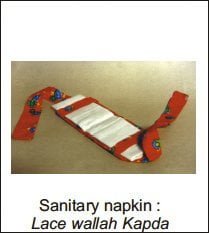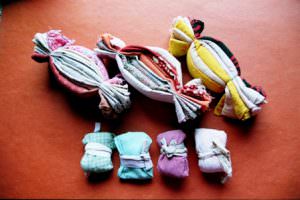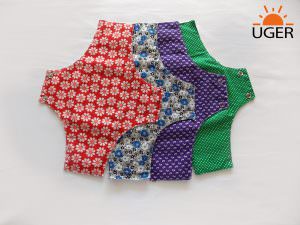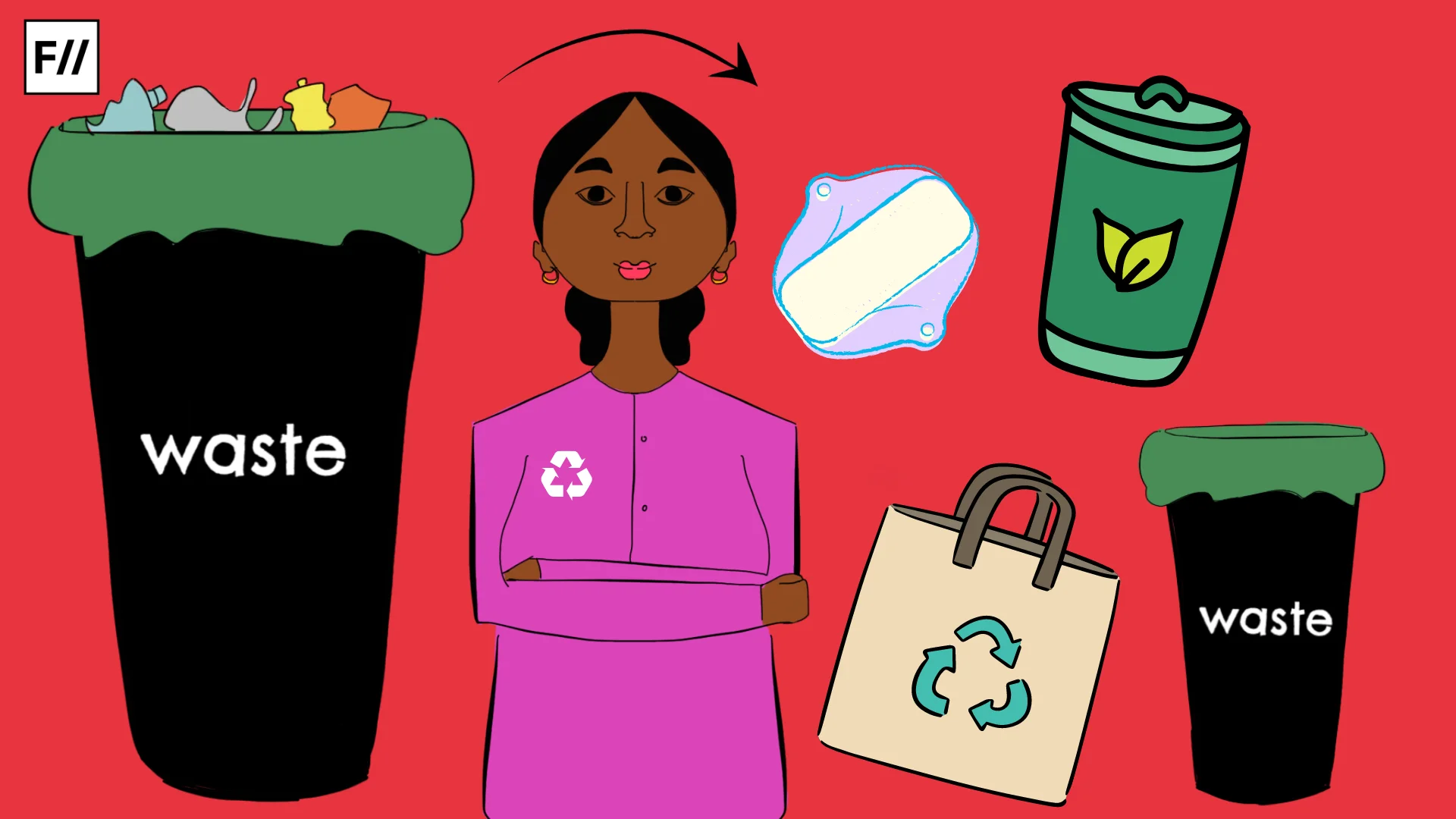 Editor’s note: Approx 125kg of sanitary waste is generated per person during their menstruating years and these sanitary napkins can take 500-800 years to break down! #ThePadEffect is a campaign to advocate for sustainable menstruation and prevent thousands of tons of sanitary waste.
Editor’s note: Approx 125kg of sanitary waste is generated per person during their menstruating years and these sanitary napkins can take 500-800 years to break down! #ThePadEffect is a campaign to advocate for sustainable menstruation and prevent thousands of tons of sanitary waste.Posted by Lakshmi Murthy
‘You are a designer Lakshmi – why don’t you make a sanitary pad design for rural women?’, Poonam Khathuria, Founder Member and Director, Society for Women’s Action and Training Initiative, to me, in the year 1998. That comment from her was the start of a long and exciting journey for me. By late nineties I had already been living and working in Southern Rajasthan. As a designer, I had been developing social communication tools, I was glued into health issues of communities, however I had limited knowledge of menstruation management. Digging deeper, I soon understood – menstruation management was a case of the proverbial Pandora’s Box.
Scenario in late 80’s through 90’s
Silence around menstruation was intense. Working with women’s groups those years, we slowly built up a knowledge base on superstitions, attitudes and practices.
- Women would only open up if they had health problems.
- It was difficult to speak to men, they had mastered the art of avoiding period talks over the years.
- Clinics and hospitals were far away and badly connected from rural areas and hence not accessed.
- Women went to nearby sources for relief – the traditional healer – the bhopa – who dispensed herbs and most often pinpoint the source of trouble to ‘being possessed’. Remedies such as sacrificing a chicken or others would be prescribed to appease gods, ghosts or ancestors – for ailments ranging from excessive white discharge to infections. The ‘health problem’ would either disappear with time or persist.
- Menstrual cloth in the form of rags was harvested from the old garments, towels and sheets. These were worn with the help of draw strings tied around the waist. In the desert regions of Rajasthan (Jaisalmer), a rectangular shaped pocket was filled with fine sand to use as an absorbent. In the hill areas of Uttrakhand, ash was used.
- Superstitions and taboos governed management – there were many, but one practice stood out – hiding menstrual cloth in dark corners away from men in the belief that they would go blind if they saw it. This made the cloth unsafe as it never got sterilised by sunlight.
- Disposable menstrual products were not commonly available at the district or block levels, one would find these only at a chemist’s shop and this would be purchased by the affluent.
- Latrines or spaces with privacy did not exist. Women changed menstrual cloth behind the bushes, in their rooms at home, typically twice a day – at dusk and dawn – giving room for potential health problems.
- Many women and girls being illiterate were marginalised from information.
At the governmental level, menstrual health was not on the community medicine agenda. In 1992, the Government of India programmes focused on aspects such as family planning which was target oriented. The Reproductive and Child Health Programme (RCH) in 1997, was not target driven, hence menstrual health got space but it was not completely addressed. In the NGO sector, Child In Need Institute (CINI – founded 1974) and Chetna (founded 1984), were some of the pioneers addressing menstrual health under reproductive health (RH), using the “Life Cycle Approach” to include every stage in a woman’s reproductive life.
Has silence around menstruation really been broken?
Individuals too were making significant contributions. Yashodhara and Abhijit Das, health activists worked for menstrual hygiene awareness in the Almora hill region of Northern India in 1999.
Scenario from 2000 to 2005
I was fortunate to be a recipient of a fellowship in the year 2000 and through this found a platform to bring design to the forefront of menstruation management by developing a reusable cloth sanitary napkin with hold up straps. Adolescent girls called this design the ‘Lace Wallah Kapda‘ or ‘Lace Wallah Gaba‘ – cloth with lace (straps) to separate this from the ordinary Kapda/Gaba – the ordinary cloth.
Lace Wallah Kapda:

The Lace Wala Kapda pad
The Lace Wallah Kapda was shared with over 1000 adolescents over the next 5 years, with girls learning to stitch the pad at workshops. I was at that time and continue to be a believer and follower of ‘copy left’ and freely distributed DIY instructions for the pad. In 2002, Oxfam representatives at Gujarat modified the design for a specific purpose, to distribute pads to women affected by the Gujarat riots in the walled city of Ahmedabad.
Goonj, another NGO, started a campaign, ‘Not just another piece of cloth‘, providing poor women clean menstrual cloth to wear during menstruation.

The Goonj Pads
In these same years, Thoughtshop Foundation, Kolkata and Vikalpdesign in Udaipur, were design studios that were continuously developing learning and training materials exclusively for RH, giving the sector tools to further their work on menstruation. At the international level Wateraid and the United Nations Children’s Fund (UNICEF) were also working on menstruation, United Nations Population Fund (UNFPA) had by this time included menstrual awareness through Life Skills Programme with adolescents.
Scenario 2005 to 2010:
These years were turning points, there was much interest, scale up and implementation in many areas.
- The government strengthened health programmes through the National Rural Health Mission (NRHM). Menstrual Hygiene was included in Accredited Social Health Activist (ASHA) workers responsibilities, giving awareness and management a huge thrust. My team was involved in the ASHA trainings and as a part of this programme we taught pad making to 800 ASHA workers in the State of Uttarakhand, with the Lace Walah Kapda start up kit, included in workers resource materials.
- In Southern Rajasthan and Gujarat, an inexpensive fabric called Time Piece or Falanel appeared in the market. Made of poly acrylate fibre this was hugely favoured by users. These dark coloured pieces of fabric, washed out easily and could dry out within two hours.
- Underwear was easily available, girls no longer liked wearing the draw string variety, preferring to keep cloth folded in the under wear.
- Arunachalam Murganathan, developed and patented a low cost machine to make disposable sanitary napkins. Many Self-Help Groups (SHGs) across the country manufactured napkins using these machines, thereby developing a distribution chain.
- Disposable sanitary products from branded companies, could now be purchased at grocery stores at the district or block level.
- Advertisements on television popularised disposable pads, many rural areas now had television and information.
- The menstrual cup – the She Cup was available in India and was being used by a small section of women.
Also Read: The “Tradition” Behind Menstrual Taboos |#ThePadEffect
Scenario 2010 to present times:
I had begun to develop a design for a cloth pad as an alternative to:
- The Lace Walah Kapda design that girls did not want any more.
- The falanel or time piece which was beginning to cause health problems due to the nature of the fabric.
This effort had not completely taken off. We had heard about Kathy Walkling and her team’s Eco Femme cloth pad movement from Auroville, Tamil Nadu. We consulted her and after strengthening our design and sale strategies with her team’s help, launched Uger cloth pads with the support of the NGO Jatan Sansthan located at Udaipur. At Jatan Sansthan we simultaneously started the Sukrashit Mahwari Abhiyan through workshop awareness and training programmes. By this time Eco Femme had started awareness and training initiatives. Both Ecofemme and Uger initiatives were collectively responding to two situations:
- The growing waste – menstrual debris from disposed sanitary napkins and tampons.
- The negative health impact – caused by polymer and gel based products on women and girls.
- Bringing back dignity to reuse sanitary pads.

Cloth pads by Uger
While these efforts were taking root, researchers were pointing out that girls do not attend school on period days as a result of having no menstrual products and places to change. This had a huge impact on our work. Disposable pads began to be distributed by philanthropic groups such as MITU Foundation.
SHGs got into action and Muruganathan’s pad making machine’s sales increased with many NGOs installing units across India. Additionally 2012 saw the government’s flagship sanitation programme, Nirmal Bharat Yatra including menstruation management as a part of the sanitation agenda, through collaborations with Water Supply & Sanitation Collaborative Council (WSSCC). Very soon the state governments in India jumped on the distribution wagon and the policy of giving out packs of sanitary napkins to every adolescent girl in government schools was started. This initiatives is still in continuance today in many states of India.
Conclusion
When I started working in the menstruation arena, I had not visualised many of the scenarios that enfolded over the years. These have been so varied, from products, to programmes to campaigns and social media movements. What a sea of change in the period world! For me personally it’s a relief to see that Sustainable Menstruation Management has become central to many women in our country who are fast rejecting disposable sanitary options such as tampons and napkins in favour of reusable products such as menstrual cups and cloth pads.
Branded companies understand aspirations of the middle class, and persuade us to switch to disposable products, telling us that they are healthier than reusable options.
In 2014, a Facebook page was launched SMI – Sustainable Menstruation in India with a handful of members, today there are more than 12,000 women members following and sharing information on aspects to menstruation sustainability. There are many cloth pad producers now when compared to three years earlier. Some Corporate Social Responsibility (CSR) projects fund Menstrual Hygiene Management (MHM) activities and interventions like Spark Minda who support reusable products and have incorporated this in their health programmes. Bihar and Jharkand governments have invited the Uger team for training the making of reusable napkins. While these maybe ‘one off’, it is still a good start.
But has silence really been broken? At many levels certainly, but as a nation we have not yet woken up to dangers of disposable products. Branded companies understand aspirations of the middle class, and persuade us to switch to throw away products, telling us that they are healthier than reusable options. Government policies on environment are in place but the ground reality is departments buy and distribute polymer based disposable products in rural locations.
In the midst of these conflicting situations what we urgently need is new ideas and new energy, in our overall goal of keeping women and our environment safe. Above all, we need men to stand with us and acknowledge that they are our partners in those period days even if they do not menstruate.
I have shared what I know. However, I realise that I may have missed many points. I apologise in advance to the many hidden heroes who may not have been mentioned in this article.
Also Read: Know Your Alternative Menstrual Products |#ThePadEffect
The author acknowledges the input of Smriti Kedia, consultant to the Uger Project at Jatan Sansthan, who assisted in editing in these notes.
Lakshmi Murthy graduated from the National Institute of Design, Ahmedabad, India in 1986 and has since lived and worked in Southern Rajasthan. Her core areas are media development and training in reproductive and sexual health. She has done extensive work in visual perception and visual literacy with non-literate communities. Her design studio Vikalpdesign is based at Udaipur. She is a founder member of Jatan Sansthan, an NGO at Udaipur and has collaborated with them for many years.
Featured Image Credit: Oxfam Nepal
About the author(s)
Guest Writers are writers who occasionally write on FII.




